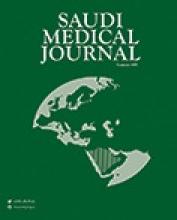Abstract
OBJECTIVE: This report aims at both estimation of the rates of overall nosocomial and urinary tract infection (UTI) and their linear trends as well as studying the potential risk factors of patients admitted to Al-Hada, Rehab and Prince Sultan military hospitals and developed nosocomial UTIs (NUTIs).
METHODS: A case-control study on 206 discharged patients with confirmed UTI and 618 controls without UTI was caried out between August 2001 through to July 2003 to study risk factors for nosocomial UTI as well as hospital records during the period (1998-2002) were reviewed for calculation of the overall annual nosocomial infection and nosocomial UTI rates.
RESULTS: Multiple logistic regression analysis showed that duration of hospital stay, unit of admission, history of diabetes mellitus or debilitating diseases, and duration and number of urinary catheters were independently associated with increased risk of NUTIs. The mean incidence rate of overall nosocomial infection along the study period (1998-2002) was 2.82, while the mean incidence rate of UTI nosocomial infection was 0.85 per 100 discharged patients. Urinary tract infection represents approximately 31.7% of overall nosocomial infection throughout the study period.
CONCLUSION: Urinary tract infections comprise approximately one third of nosocomial infections. The results, thus, indicated that to reduce the incidence of UTI nosocomial infection, it was important to take factors that can be managed into consideration. Therefore, the involved persons should pay more attention and set practical and effective guidelines for the hospital.
- Copyright: © Saudi Medical Journal
This is an open-access article distributed under the terms of the Creative Commons Attribution-Noncommercial-Share Alike 3.0 Unported, which permits unrestricted use, distribution, and reproduction in any medium, provided the original work is properly cited.






